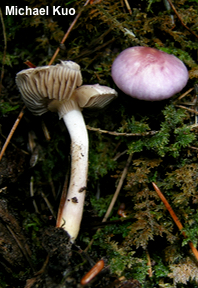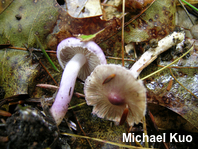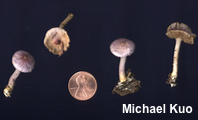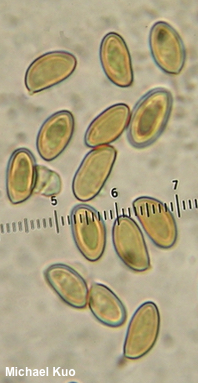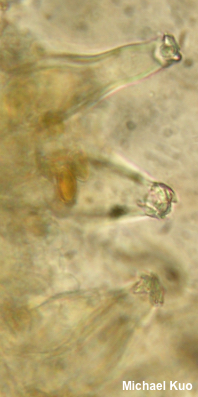| Major Groups > Gilled Mushrooms > Dark-Spored > Inocybe > Inocybe lilacina |

|
[Basidiomycota > Agaricales > Inocybaceae > Inocybe . . . ] Inocybe lilacina by Michael Kuo, 14 April 2024 As its species name suggests, Inocybe lilacina is lilac colored—in fact, it often pushes the limits of "lilac" in favor of "purple," especially when young. Other identifying features include its brown spore print, its strongly spermatic odor, and the cob-webby white cortina evident on young specimens. Under the microscope, Inocybe lilacina features smooth, ellipsoid spores and funky cystidia that develop apical crystals. Until fairly recently these features would have served to identify Inocybe lilacina successfully—but a 2018 publication from Matheny and Swenie, representing a three-gene phylogeny of many putative "Inocybe lilacina" collections, found support for the presence of at least four lilacina-like phylogenetic species in North America. According to Matheny & Swenie, the true Inocybe lilacina, represented by its type collection and many other collections, can be recognized by its small stature (the stem is generally 2–3 mm thick) and the fact that the center of its cap is purple and remains at least partially purple through development. Distribution of Inocybe lilacina appears to be limited to the eastern United States. Inocybe ionocephala is somewhat larger (stem to 1 cm thick) and features a white, rather than lilac, stem; it occurs in coastal California. Two virtually inseparable species, Inocybe pallidicremea and Inocybe sublilacina, feature cap centers that are yellowish rather than purple, lilac colors that fade more readily, and somewhat more robust fruiting bodies (stems 3–6 mm thick) than Inocybe lilacina. The name Inocybe lilacina is used in Europe for a very similar mushroom; Matheny & Swenie determined a Finnish collection to be closely related to the North American species, but distinct. And if the morphological separators that help to separate the North American species operate in Europe (that's a big "if"), there may be several European lilacina-like species; photos in some European guides (e.g. Læssøe & Petersen 2019) appear to represent purple-centered mushrooms that remain purple through development, while others (e.g. Breitenbach & Kränzlin 2000) represent paler, pallidicrema-like mushrooms. Also compare Inocybe lilacina to Cortinarius iodes and other small, purple species of Cortinarius; these have rusty brown spore prints and very different microscopic features. Inocybe geophylla var. lilacina is a synonym. Description: Ecology: Mycorrhizal; growing alone, scattered, or gregariously, apparently in association with both conifers and hardwoods; originally described from New York (Peck 1873); distribution uncertain because of previous confusion with other species (see above), but documented with certainty by Matheny & Swenie (2018) from upper New York to the southern Appalachians; reported, possibly erroneously (see above) from Europe. The illustrated and described collection is from Kentucky. Cap: 1–3 cm; convex at first, with the margin a little inrolled, becoming broadly convex or flat but retaining a central bump; sticky when young but soon dry; radially silky-fibrillose; purple to lilac, often with a darker purple center, fading somewhat to lilac, or eventually becoming buffy-brownish with a purple center. Gills: Broadly to narrowly attached to the stem; close or nearly distant; short-gills frequent; buff at first, becoming pale brown, then snuff brown; edges whitish; at first covered by an ephemeral, whitish cortina. Stem: 2–4 cm long; 2–4 mm thick; equal above a slightly swollen base; dry; silky or bald; whitish to lilac above and lilac to purple below; becoming hollow; basal mycelium white. Flesh: Insubstantial; whitish; not changing when sliced. Odor: Strongly spermatic. Chemical Reactions: KOH negative on cap surface. Spore Print: Dull snuff brown. Microscopic Features: Spores 10–12 x 4–5 µm; ellipsoid to subamygdaliform, with a small apiculus; smooth; yellow-brown in KOH. Basidia 20–23 x 5–7 µm; clavate; 4-sterigmate. Cheilocystidia 40–65 x 10–15 µm; mostly lageniform but also broadly cylindric or saccate; smooth, but developing apical crystals; walls 1–2.5 µm thick; hyaline in KOH. Pleurocystidia similar to cheilocystidia. Pileipellis an ixocutis; elements 3–6 µm wide, smooth, hyaline to brownish in KOH; clamp connections present. REFERENCES: (C. H. Peck, 1874) C. H. Kauffman, 1918. (Kauffman, 1918; Kauffman, 1924; Smith, 1949; Smith, Smith & Weber, 1979; Phillips, 1980; Arora, 1986; States, 1990; Schalkwijk-Barendsen, 1991; Lincoff, 1992; Bessette, Miller, Bessette & Miller, 1995; Evenson, 1997; Barron, 1999; Breitenbach & Kränzlin, 2000; Boccardo et al., 2008; Buczacki et al., 2013; Kuo & Methven, 2014; Gminder & Böhning, 2017; Elliott & Stephenson, 2018; Jacobsson & Larsson, 2018; Matheny & Swenie, 2018; Sturgeon, 2018; Læssøe & Petersen, 2019; McKnight et al., 2021.) Herb. Kuo 10160403. This site contains no information about the edibility or toxicity of mushrooms. |
© MushroomExpert.Com |
|
Cite this page as: Kuo, M. (2024, April). Inocybe lilacina. Retrieved from the MushroomExpert.Com Web site: http://www.mushroomexpert.com/inocybe_lilacina.html |
